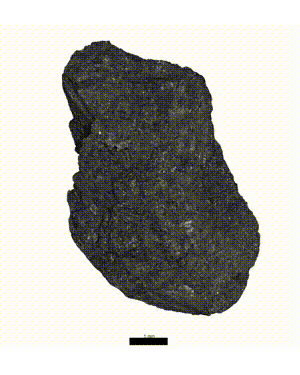5.11.2023

In addition to the Bennu sample, visitors to the Smithsonian's National Museum of National History in Washington, D.C. can also see scale models of the OSIRIS-REx spacecraft and the Atlas V 411 rocket that carried the spacecraft. (Smithsonian/James Di Loreto and Phillip R. Lee)
A sizable crowd turned out to see a small rock on Friday (Nov. 3), as the Smithsonian debuted the first display of a piece of the asteroid Bennu from the sample brought back to Earth by NASA's OSIRIS-REx mission.
The institution's National Museum of Natural History in Washington, D.C. hosted NASA Administrator Bill Nelson and other space agency and Smithsonian officials at an unveiling ceremony for the well-traveled pebble. The OSIRIS-REx (Origins, Spectral Interpretation, Resource Identification, and Security-Regolith Explorer) spacecraft safely landed its sample return capsule on Sept. 24 in the Utah desert, completing a 2.5-year, 1.4-billion-mile (2.3-billion-kilometer) journey from Bennu.
"I am beyond excited to welcome you to the National Museum of Natural History for a moment I started dreaming of 20 years ago," said Tim McCoy, the museum's curator of meteorites and a member of the OSIRIS-REx science team. "That [a] sample of an asteroid returned by a spacecraft would join us here."
"What we are doing today is a just a milestone. It is a start in where we are going," he said. "Where we are going is trying to use this sample to really understand our unique planet."
About 50 people, including members of the press and public, crammed into the meteorites section of the museum's Janet Annenberg Hooker Hall of Geology, Gems and Minerals to be among the first to see the Bennu sample go on display. Presented within a stainless steel bottle with a glass viewing port, the jet black rock is enveloped in a pure-nitrogen environment to keep it pristine.
Flanking the display of the roughly 0.3-inch-diameter (8-millimeter), 0.005-ounce (143-milligram) stone are two models. On its left, is a 1:84 scale replica of the United Launch Alliance (ULA) Atlas V rocket that powered the start the asteroid sample return mission in 2016. On the right, is a 1:24 scale model of the Lockheed Martin-built OSIRIS-REx probe.
"Could this fragment of an asteroid hold information about the beginnings of our Solar System and the formation of life on Earth?" reads the backdrop for Bennu sample display. "Scientists can now study the water-rich minerals and carbon-rich molecules formed before life contained within to better understand the origins of the Solar System, Earth's oceans and life itself."
A CT (computer tomography) scan of the fragment — labeled by NASA scientists at the Johnson Space Center in Houston as OREX-800027-0 — showed that the stone is made up of dozens of smaller rocks that were fragments cemented back together and that the entire piece was heavily altered by water, producing clays, iron oxides, iron sulfides and carbonates as its major minerals, along with carbon.
"It was really a matter of finding a stone that we thought was typical of the kind of material [that was brought back] and we needed something that was durable. To put this in here, it needed to be transported across the country," said McCoy of how this specific rock was chosen for display. "We [also] wanted something that was photogenic, so something that was relatively flat."
NASA scientists narrowed the selection to five or six candidate stones.
"It was sort of the Goldilocks effect — this one was too big, that one was a little too small and they found one that was just right," said McCoy. "And that's what we get to share with the American public."
In addition to the stone now on display, the Smithsonian was also loaned another Bennu fragment for scientific study.
Two additional rocks will follow on display at the University of Arizona's Alfie Norville Gem & Mineral Museum in Tucson and at Space Center Houston, located adjacent to NASA's Johnson Space Center in Texas, where most of the Bennu samples reside for scientific study. Opening dates for those exhibits are still to be announced, though may be as soon as Nov. 15 according to one of the venues.

From left to right, Smithsonian Under Secretary for Science and Research Ellen Stofan, National Museum of Natural History curator of meteorites Tim McCoy, and NASA Administrator Bill Nelson unveil the first public display of a sample from asteroid Bennu, Friday, Nov. 3, 2023, at the Smithsonian's National Museum of Natural History in Washington, D.C. (NASA/Keegan Barber)

The OSIRIS-REx Bennu sample display case (at far left) now on view in the Janet Annenberg Hooker Hall of Geology, Gems, and Minerals meteorite gallery at the Smithsonian's National Museum of Natural History in Washington, D.C. (Smithsonian/James Di Loreto and Phillip R. Lee)
Quelle: CS
